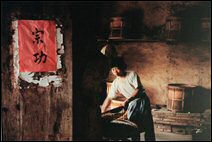The Modern Tea Steeping Custom EmergesNot until the Ming Dynasty (1368 to 1644) was tea prepared as it is today, by steeping leaves in water. Instead of compressing tea leaves into bricks, the leaves were dried, rolled and then heated in iron woks to dry. The dried leaves were steeped in hot water. The Chinese government further established a hold on tea trade by opening a Bureau of Tea and Horses, regulating interactions on the frontier, where people traded tea for horses. From 1644 to 1911, the Qing dynasty ruled China and eventually abolished duties on tea—a testament to how essential tea had become to everyday life and the economy.
Tea Entices The WestAlthough Europeans did not see tea until the 17th century, it appeared earlier elsewhere in the West. Around the 9th century, references in Arab trade documents refer to the process of boiling bitter tea leaves. But it took many more centuries for tea to get to the Continent.
In spite of such early reports of tea, the product itself was did not arrive in Europe until 1610. Russia discovered tea in 1618 after the Czar received a gift of it from the Ming emperor, although some reports have it arriving earlier via camel caravans that came from China, traveling part of the way on the famous Silk Road.
Continue To Page 4: The British East India Company & Tea Plantations In India Return To Article Index At The Top Of The Page
|

The Nibble Blog
The Latest Products, Recipes & Trends In Specialty Foods
The gourmet guide you’ve been waiting for. New food adventures are served up daily. Check it out!

Food Glossary
Our Food Directories Are "Crash Courses" In Tasty Topics
Your ultimate food lover’s dictionary packed full of information and historical references. Take a look!

Food History
Let the journey begin!
Learn about the history Of 1,000+ Favorite Foods & Beverages Let’s explore the history of your favorie goods together.Let the journey begin!


